Tag: Petit Manseng
You Never Forget Your First Crush
Scott Elliff of DuCard Vineyards once told me that harvest was a joyous time, the culmination of a year’s hard labor tending the vines. And on September 21, after four years of planning, preparation, and hard work, we experienced that joy in our own vineyard, picking grapes from the vines we had planted with our own hands and nurtured like our own children. If I’m at this ten years from now, I’m sure I’ll still find joy in the harvest, but I doubt that it will be anything like the euphoria I felt as we picked those first Cab Franc grapes this year.
To recap a bit, the Vineyard Goddess and I began this adventure some four years ago. We took classes on viticulture and enology at Piedmont Virginia Community College, did lots of research on our own, debated which clones and which rootstocks to order, and finally planted our vineyard in the (very) early spring of 2012. Since then, we’ve invested a lot of sweat, a couple of tears and even a little blood (I snipped my finger with the pruning snips during the harvest) in bringing those vines to the point where they were ready to produce a crop of grapes worthy of picking.
And, oh my God – did those vines ever produce!
The Cab Franc and the Petit Verdot were absolutely magnificent: nearly perfect fruit that proved irresistible to the bees that laid siege to those rows of vines. The Merlot, for whatever reason, fell behind. I had thought we’d pick the Merlot first among the reds, and by all rights we should have. But after accumulating sugar at a rapid pace, the Merlot vines just shut down. We picked them October 5, and I’m hoping for the best.
The Viognier was disappointing. Virginia-grown Viognier makes a wonderful wine, but it’s hard to grow. For some reason it’s subject to something called primary bud abortion, and I guess our vines experienced that phenomenon, because the Viognier was the least fruitful of all our varieties. The grapes looked lovely, but I had expected about 100 pounds or so, and we got about 20. Other vineyards around the Commonwealth had the same experience, though on a totally different scale (the difference between tons and tens of pounds).
The last of our varietals is Petit Manseng, and those grapes looked beautiful when we harvested them two weekends ago. We want to make a desert wine from them, and so we let them hang a bit longer than we might have. We had hoped they would accumulate a little more sugar and lose a little more acid. If we had known we were in for some pretty significant rain the week prior, we might have chosen differently, but weekend vintners like us have to make some tough decisions and then live with them. As it turned out, we didn’t get the extra sugar or the lower acidity. We’ll work with it.
But getting back to where I started, there are some things you never forget. I can still remember the first crushes of my life – the first time I saw the Vineyard Goddess in the newsroom of our college newspaper, the first book I really fell in love with (thank you, James Joyce), the first time I saw my children, and the first time I saw Venice, walking out from the train station on a beautiful sunlight day to see the Grand Canal sparkling with life. Some things you just never forget.
And so, I don’t want to get too sentimental about this, but when we had finished picking the Cab Franc on that beautiful September morning, the VG and I hugged and felt a sense of euphoria. All those years, all that sweat, and all that worry behind us; now we had the fruit of our labor in front of us, collected in a dozen five-gallon Home Depot buckets. It was one of the most wonderful moments of my life.
A little detail: we had gotten up at first light that morning to pick, and we finished before the sun hit the vines. The early morning, especially this time of the year, is cool, and you want the grapes to hit the crush pad (i.e., our driveway in Fairfax) cool. The crush, by the way, is the term applied to the harvest and the process of preparing the grapes for fermentation.
As we picked, we stored buckets in a refrigerator we had purchased just for this task. With the shelves removed, we could fit six buckets, stacked on top of each other, separated by the shelves I had pulled out and repurposed. As we brought more grapes up from the vineyard, we pulled the buckets from the frig and dumped them into a 120 quart cooler from Costco. When it was filled, we pulled out smaller coolers. The grapes were cool to the touch right up to the crush, and the must came in at around 60 degrees or lower.
As it turned out, picking the grapes was the easy part. I had done a lot of research and reading, a lot of planning, and a lot of online shopping for the equipment and supplies we would need. But for all that work, when it got down to actually making the wine, I found myself in the weeks before the harvest feeling a bit lost.
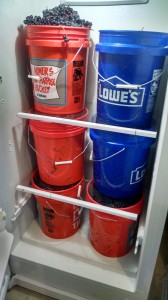
A refrigerator full of wine grapes — this is about half the load of Cab Franc. We dumped these into the cooler and refilled the frig.
So, before we picked the first grapes, I started making a cheat sheet. It went something like this:
First, add sulphur at a rate of 50 parts per million (.33 grams per gallon), which kills off unwanted natural yeasts and protects the must (the mix of juice, skins, seeds, and stems that will turn into wine) during those vulnerable hours before fermentation begins. Next, check the brix, pH and TA (titratable acidity) of the must (add a dozen steps here). Rehydrate the yeast (add a half-dozen steps here). And so on. (Add dozens and dozens of individual steps.) And for all that, I found myself furiously reading the instructions (again) on my lab test equipment to be sure I knew how to test the TA, and reading other literature on hydrating and preparing yeast.
When we arrived back in Fairfax, we started with the easy stuff: the sorting table. We had purchased a folding table, which turned out to be the perfect place for the family and friends to gather around for some work and talk. Kind of like what I imagine a quilting bee was like a century or so ago. We pulled some chairs around the table, and the VG and I, plus daughter Kate and a couple of neighbors, sorted the grapes. That’s easy and straightforward, but it’s also very time consuming.
The fruit was amazing, so we didn’t throw away very much at all. Mostly, we were looking for MOG – matter other than grapes. We found the occasional spider web (with the spider, in most cases, which elicited a few screams), and some extra leaves and such. But the fruit that went into the crusher was just about perfect.
The crusher-destemmer was way more of a machine than we really needed. It crushed the fruit faster than we could drop it in, and we were finished with that part of the process in maybe ten minutes. Honestly, cleaning it took way longer than the actual crushing. But I’m still glad I bought it. More on that in another post.
In the end, the Cab Franc yielded some 20 gallons of must – juice, grape skins, seeds and some stems that fell through the destemmer. As luck would have it, I had a 20 gallon bucket on hand to catch it all. Again, we’re still on the easy part.
I weighed the sulphur (potassium metabisulphite), mixed it with distilled water and added it to the must. And then, I spent hours measuring the pH and TA and brix, deciding whether to adjust the sugar level or acidity (I decided not to), and preparing to pitch the yeast. And in between, I cleaned out the crusher, the extra buckets, and everything else I used in the process. Not to mention sanitizing everything that came into contact with the must.
I have always used potassium metabisulphite for sanitizing, but now, with my own grapes at stake, I worried a bit. I had used sulphites at 50 ppm to protect the must, and the mix for the sanitizing solution was much stronger than 50ppm. So I decided to go with Star San, an acid-based sanitizer that requires no rinsing afterward. Pretty much every bone in my body was calling for sulphur, but I resisted.
It was some day. We were in the vineyard at about 7 a.m., and it was close to 10 before I pitched the yeast, which started the fermentation (Not right away mind you; no, the yeast played with me, waiting days before they actually began to ferment the must).
Much of the time spent that day involved nothing more than anxiety – wanting to get everything just right and worrying that I was getting everything just wrong – but another part of it was the actual physical labor involved. By the time the day was over, I was exhausted, and the memory of hugging the Vineyard Goddess at the end of the harvest was just that – a distant memory.
Well, I suppose in the end, it’s like dating the first girl you had a crush on – the hopes, the anxiety, the desire to get everything just right, the certainty that you have gotten everything totally wrong, and the physical exhaustion that comes from working so hard.
But I’m hoping this crush is like the time I laid eyes on the Vineyard Goddess for the first time. If this crush is as perfect as that one, we’ll have a wine for the ages.
A Tough Year for a Weekend Vintner
It was a tough year to be a weekend vintner.
When you’re separated from your vineyard by a two-hour drive, you have to make the most of your time. And we try. But the weekends are short, and there’s so much to do. And every curve that Mother Nature throws your way puts you just a little bit further behind. This year, Mother Nature was throwing curves, sliders, and the occasional spitball.
This year began with a late spring frost, followed by rain. Not just a little rain, but lots of rain, which gave rise to all kinds of fungal disease potential. Powdery Mildew, Downey Mildew, Botrytis, you name it.
And then came the pests: Japanese beetles, birds, raccoons, squirrels, deer, and even bears. Yes, indeed, bears. No lions or tigers,though. Just birds, deer and bears. And yeah, racooons and beetles and the rest of the pests.
That’s one of the reasons I’ve not been able to pay much attention to this blog. Another was that Chris and I took on responsibilities for editing Grape Press, the quarterly publication of the Virginia Vineyards Association. But mainly it was the challenges of the growing season. It seems like we spent all of our spare time each weekend keeping up with the vineyard. Spraying, cultivating, pruning, and spraying. Yeah, lots of spraying. It wasn’t easy.
Let’s start with the late frost. I remember arriving at the vineyard early one Saturday morning to find our whites all but devastated. Honestly, it looked as though someone had sprayed Round-Up and left them to die. For a while, I actually wondered if they had been the victims of spray drift from the herbicide we had used to clear a row for new the new vines we had planted this year.
Fortunately, that was not the case.
After checking the temperatures recorded nearby, I realized that we had probably experienced at least one and possibly two frost events in which temperatures had dropped just below freezing for a few hours in the early morning. My reds were fine, but they are planted higher on the slope and there’s a good possibility that temperatures stayed a degree or two higher in their part of the vineyard. Alternatively, bud break came earlier for the whites and they may have just been victims of bad timing. I’ll never know.
It turned out okay, though. Both the Petit Manseng and the Viognier had enough secondary buds left to generate growth for this year. Within a few weeks, we were seeing buds break and shoots begin to develop. And by the middle of the summer, they were looking like grape vines again. So, all was well.
But then it started to rain. Continue Reading–>
Looking Back on the First Year
So, now that we’ve been through most of a full season, from preparing the ground and putting in the trellis, to planting and nurturing the vines all the way through the “harvest” (three clusters that grew despite our efforts to keep the vines free of fruit), I think it’s time to enjoy a glass of someone else’s wine, reminisce happily about how well everything turned out, and then get down to the serious business of evaluating what we did right and what we did wrong. On the plus side, I think we got a lot of things right. We spent more time than I care to remember researching and thinking through what varietals we would plant and more specifically, what clones would do best on our property – 740-feet above sea level, on a steep, westward facing slope in Afton. We settled on four grapes – Cab Franc, Petit Verdot, Viognier and Petit Manseng – and I’m very happy with the choices we made. We’re thinking of putting in some Merlot next spring, but I think the four we started with are great grapes for Virginia.
- My job was to dig the holes. . .
- In a more or less straight line.
- And my wife, the Vineyard Goddess, did most of the planting.
We decided to go with ENTAV clones, and worked through three different nurseries to get the vines we wanted. For the record, we ended up getting ENTAV 214 Cab Franc; ENTAV 573 Petit Manseng; ENTAV 400 Petit Verdot; and ENAV 642 Viognier. We put all of them on 101-14 rootstock. Continue Reading–>
No Grow Tubes, No Round Up, No Sweat. (Well, maybe a little.)
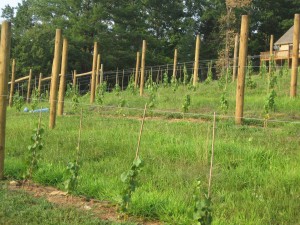
A view of our vineyard
We decided a year ago, after planting a small, educational vineyard (i.e., seven vines, planted for the sole purpose of getting some hands-on experience with viticulture) to forego the use of grow tubes. That was a tough choice. Almost every vineyard we’ve visited nurtures young vines in grow tubes, and there’s probably good reason to use them in large commercial undertakings.
But we decided against them for our small hobby vineyard for reasons that we think make sense. Most of the research we’ve looked at suggests that vines raised without grow tubes do better in the long run than those that spend their formative months inside protective shelters. We happened to speak to a vintner from South Africa over the weekend, and he echoed our views, noting that he had not even seen a grow tube before arriving in the United States. He still believes, he said, that the vines are better off without them.
But, of course, everything comes with a price. And this weekend, we got a real taste of the price you pay for growing vines without protective shelters.
The main reason vineyards love grow tubes is because it makes cultivation easy. You can spray herbicides such as Round Up around the vine to kill off the weeds without having to worry that your Cab Franc will die with them. Okay, I know that’s not a controversy-free statement. Advocates of organic wine, natural wine, biodynamic farming and so on will object right off the bat to the use of herbicides, however easy they make the task of maintaining a vineyard. And my heart is mostly with them, for a variety of reasons I’ll explore in future posts. But the fact is, keeping the weeds down without Round Up can be just plain drudgery.
Trust me, I have the aching muscles to prove it.
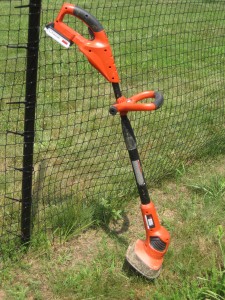
Our battery-powered cultivator, standing tall and proud
Now, it’s true that our vineyard is small. Right now we have only 150 vines, and the space they take up wouldn’t fill a small corner of even the smallest of the Commonwealth’s commercial vineyards. So we thought we could afford a few luxuries when it came to maintaining the vineyard. But it turns out that pulling weeds by hand is work – really, really, really hard work.
We started off a few weeks ago with nothing more than a hoe and our own hands. And by “we,” I mean my wife, the Vineyard Goddess, as I was still recovering from surgery on my cervical spine (Level 4 ACDF for those of you who know or care about these things). I was there in spirit, but it was the Vineyard Goddess who was working the soil with a hoe, and then kneeling down to pull the weeds by hand. I wasn’t actually there, but I have no doubt that it was slow, painful work.
And I know that, because we talked about it. I might have been unable to do physical labor, but I was still available as a consultant, and it occurred to me that there might be mechanical devices to help with this chore. Sure enough, there are. My preference would have been a small, gas-powered cultivator, but with our very steep slopes, we were concerned that we wouldn’t be able to control it well enough to avoid damage to the vines.
We looked at the somewhat smaller electrical tillers, both corded and battery-powered, and settled on the latter. The corded ones are probably perfect for a garden located next to the house, but our vineyard is a significant hike from the house. And the furthest rows are, as they say, “a fur piece.” Continue Reading–>
Spring in the Vineyard
Cab Franc vines, still protected by mounds of dirt, showing exuberant growth before being un-hilled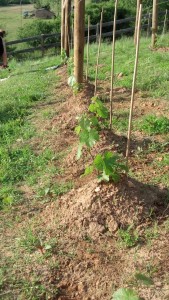
Despite months of crazy weather, it's finally springtime in the vineyard. And after all the hours of planning and research and all the work that went into getting the vineyard ready for planting vines – not to mention the planting itself – I was pretty bummed about not getting to see the early fruits of our labor this weekend. My wife, Chris, ably assisted by daughter Kate, the vineyard volunteer worker, traveled to Afton without me this weekend to un-hill new vines, continue the work on the deer fence, and handle a dozen other tasks that demand attention in the spring.
So, this isn’t exactly an eyes-on report from the scene. It’s more like something cobbled together by an editor hunkered down in a newsroom, piecing together a story out of dispatches sent in by reporters from the front lines. I've been both a reporter and an editor in my life, and believe me, being a reporter is way more fun. Editors sit behind desks in newsrooms waiting for reporters to tell them what’s going on. When I was an editor, I generally got cranky while waiting. Reporters get out of the office and see things happen. Even in the day of Blackberries and instant communication, I'm sure they still keep editors at bay during the day by telling them there’s way too much going on to stop and talk. And they’re usually right.
Petit Verdot vines after removal of the earth mounds, or hills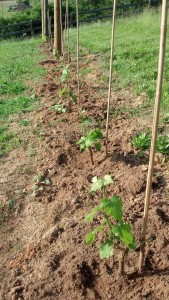
In this case, Chris and Kate filed their dispatches by text messages, emailed pictures, and a number of old-fashioned cell-phone calls, all of which provided some color on the early progress our vines are making. I have to say, we’re just thrilled with the results. Out of the 150 vines we planted this spring, only one appears to be clearly dead, according to the reports I've received, although another ten are doubtful. But the rest look magnificent! (Especially in the pictures.)
I’m particularly pleased with the progress of the first group of Cabernet Franc vines that we transplanted from our Fairfax vineyard two weeks ago. They not only survived, but they’re flourishing. And they have fruit! Big clusters of berries that will turn into grapes very soon if we leave them on the vine. Which, of course, we won’t. Even if the vines hadn’t been through the shock of being dug up in Fairfax and replanted in Afton, they’re still only in their second year of life, and they needto devote all of their energy to developing a strong root system and trunk. So we’ll be dropping the fruit soon.
Clusters of berries that would eventually be Cab Franc wine grapes if we let them continue to mature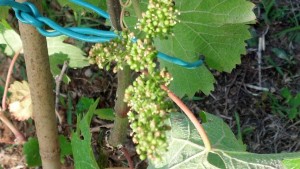
We had planted seven Cab Franc vines in Fairfax a year ago, all for the purpose of getting additional hands-on experience working with vines. This weekend, Chris dug up the last three and moved them, so the Fairfax “vineyard” is officially defunct, although it lives on in spirit in Nelson County. We can’t be sure that all seven will make it, but we’re very hopeful.
Cab Franc vines still in transplant shock from being moved on May 19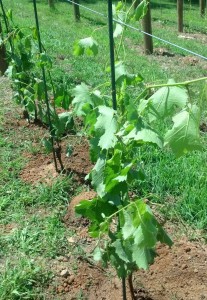
In any event, I'm glad we tried this experiment, which was prompted by an article by WineMaker’s magazine’s Wes Hagen. He recommended ordering extra vines and planting the excess closely together on some spare land. That way, you have some surplus vines to replace the ones that inevitably will die. And that’s one of the sad facts of viticulture. No matter how good you are, no matter how carefully you plant, and no matter how great the nursery you buy from, you’re going to lose some plants. So, even though some of the 50 Cab Franc vines that we planted this year will surely die, with the additional one-year old vines Fairfax we should end up ahead of the game. Wish I had read the Wes Hagen advice before we ordered vines for planting this year.
Looking at the rest of the vinyeard, our whites are doing quite well. We planted 25 each of Petit Manseng and Viognier on the weekend of March 31, and mounded hills of earth over them, covering the graft union with about two inches of soil to protect the dormant vines from the possibility of late frost. We un-hilled them two weekends ago on May 6, and they have been doing quite well ever since.
Close up of a Petit Manseng vine that was planted April 21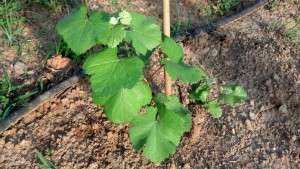
Likewise, the reds are showing great promise. Chris and Kate un-hilled the 100 Cab Franc and Petit Verdot vines that we planted over three days in early April. Both grapes seem to do well in Virginia, and we are wildly optimistic about their potential. Which, of course, puts us in the company of farmers everywhere who start each spring full of optimism, no matter how bad the previous year went. And don’t get anyone started talking about the 2011 vintage. Trust me, just don’t.
A row of Viognier vines - all healthy so far!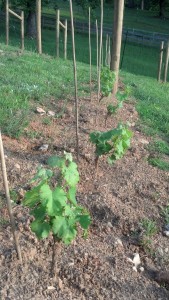
By the way, the un-hilling I did two weeks ago involved a lot of careful work with my hands, but it was positively crude compared to Chris’s method. I pushed the dirt aside a little bit at a time, until the vine was completely uncovered. Okay, maybe a spare bud or two got knocked off in the process.
Chris would have none of that. She bought a makeup brush for the final removal of soil from the vines, and claims it worked like a charm. I wasn’t there, so I’ll take her word for it. It seems like a pretty time-consuming approach, so I’m pretty confident that I’ll do my part of the un-hilling next year sans the makeup brush. Unless of course the vines she un-hilled do better than mine. Let’s not even go there, okay?
And there’s still so much work to be done. I think I’m recovering well enough from surgery that I’ll be able to be in Afton myself for the next trip. Chris and Kate have gotten to be quite the dedicated and skilled vineyard workers, handling everything from driving posts into the ground to planting vines. I’d sure like to be able to lend a hand. Or at least be there to watch with great enthusiasm while they do the work
On Deer Fences and Surgery
With the new vines in the ground and growing beautifully, the need for a deer fence was growing ever more urgent. Deer are only one of many pests that will go after the grapes once the fruit reaches a certain level of sweetness, but they will also go after the shoots themselves. With all the work we put into this small hobby vineyard, we don’t want the vines to end up becoming a McDonalds for the local deer population.
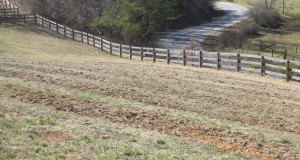
- The entire property has a three-board fence, with added wire meshing — good for keeping critters off the property, but not high enough to stop deer.
This seemed like an easier task than putting in the trellising system, but even so, we spent a fair amount of time researching deer fences over the previous month. In our division of labor, I had worked out the details on the trellis, and my wife, the Vineyard Goddess, devoted herself to the deer fence.
Traveling around area vineyards, we got a sense of the variety of fences that were being used. Some vineyards have installed metal fences as high as 10 feet, but that seemed like overkill for us.
Our property is already surrounded by a four-foot high, three-board wood fence that has a metal mesh fence attached to keep small critters out and our two Vineyard dogs in. We briefly toyed with the idea of doing something to raise the height of that fence by another four feet all around the property, but rejected that approach for two reasons.
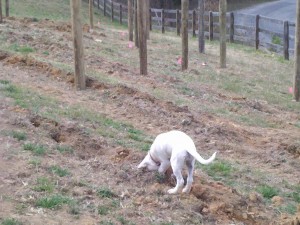
- And here Glory is demonstrating why a separate fence around the vineyard itself is absolutely essential.
First, it’s a whole lot of fence — about 1,100 feet. For about $8 a foot, we probably could have put in a fence that would be way more utilitarian than aesthetically pleasing, but this property will someday be our home, so we’re going for aesthetically pleasing. And second, while it would keep our dogs from wandering off the property, it would do absolutely nothing to keep them out of the relatively smaller vineyard area inside our property.
Phoeneix, the vineyard dog, isn’t so much of a problem by himself. He shows a certain Continue Reading–>
Planting the Vineyard, Part I
With the trellis posts finally in the ground, we were finally ready to plant. And not a moment too soon.
When we arrived in Afton on Friday evening, March 30, we had 50 dormant vines waiting for us: 25 Petit Manseng from Vintage Nurseries in Wasco, California, and 25 Viognier from Sunridge Nurseries, Bakersfield, California. The largest number of vines we had ever planted before was seven, and we weren’t sure how long it would take to get
these vines in the ground, or even if we’d be able to get it done by the end of the weekend. But we had another 100 vines set to arrive the following weekend, which meant we didn’t have much of a choice. We decided to plant the Petit Manseng first, and prepared them by putting them in a bucket of water to soak overnight.
In the morning, we inspected the vines to see if they looked healthy. This was kind of like the time in high school when my car wouldn’t start as I was taking my date home. I opened the hood, looked inside as though I knew what I was doing, and just prayed it would start when I got back in the car. It did start up, Continue Reading–>
Building the Trellis, Part I
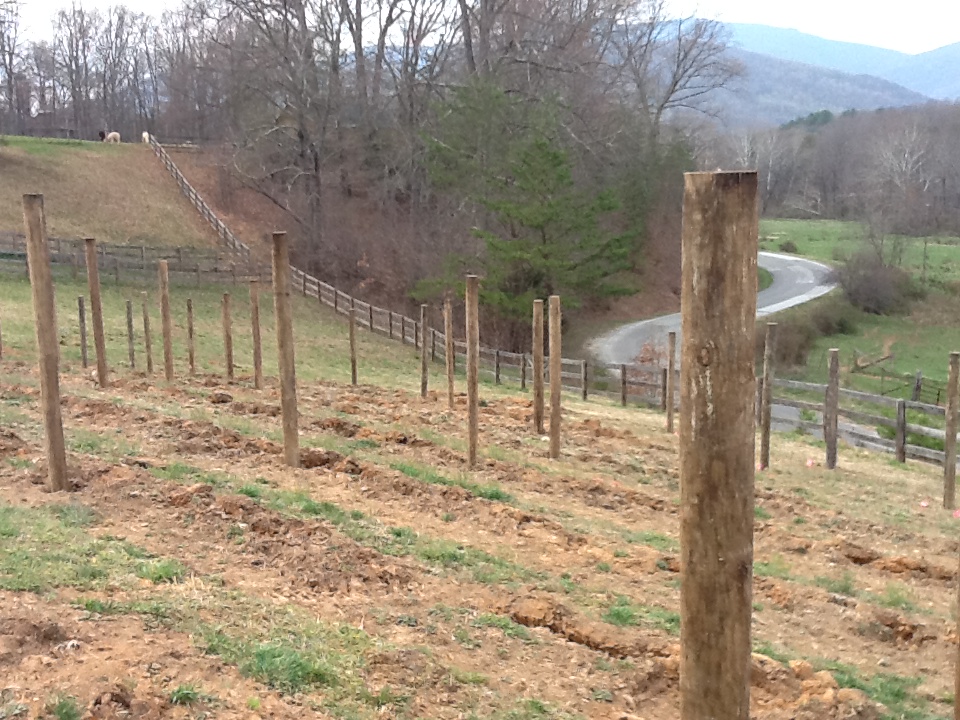
Here's how the vineyard looked last weekend, March 17. The posts are in the ground, the rows have been ripped, and it's beginning to look like a real vineyard! You can see our neighbors, the Alpacas, on the hill, top left.
How we built the trellis
Well, I have to be honest, I didn’t exactly build it myself. Much as I wanted to install the posts with my own hands, I ended up short on time with the planting season upon us. We needed to get the vines in the ground, pronto.
I’d spent much of the winter, between viticulture classes, my job and all of the work that goes into maintaining two separate properties, thinking about how to handle the trellis. There were moments when it seemed simple enough — eight foot posts put 24 to 30 inches into the ground, plus some kind of end-post system, which would be only slightly more complicated. And then, there were times when I wondered if I was up to the job.
As part of the planning, I did some research on what kind of equipment I’d need to buy or rent. A lot of the literature suggests that the best way to put posts into the ground is to pound them in, but the equipment involved would have made that impractical for me to do on my own. The easiest way to get the posts in is to drill the holes with an auger.
So, I briefly considered the idea of a hand-held power auger, which was the least expensive approach, or an auger for my tractor. I spent a lot of time visualizing the process, and considering whether it would be more cost-effective to do it myself or hire someone to do the work. I was pretty confident I could get the line posts in without a problem, but I spent a lot more time worrying about the end posts, which are more complicated. At some point, I began waking up at 4 a.m. to worry about how much work needed to be done and wonder if the vines we had ordered were destined to just, uh, rot on the vine? No, bad metaphor. Go to seed? mmmm…. no, that doesn’t work either. Wither and die? Well, something like that.
Eventually, we passed the point where I could reasonably expect that it would be Continue Reading–>
Dormant Winter Pruning — and other Vineyard Considerations
After a long winter that sometimes seemed like it would never end, spring planting is just around the corner. And despite all the time we had to prepare for the new season, we are now feeling not quite as ready as we’d like to be.
We’ve ordered 150 vines –50 Petit Verdot, 50 Cab Franc, 25 Viognier and 25 Petit Manseng – and lately I’ve been waking up in the middle of the night wondering if we’ll have everything in place in time to plant. I’m still worried, but we’ve made enough progress lately, especially this weekend, that I’m feeling a bit better about the whole enterprise.
Our biggest concern is the trellis. If you’ve followed our progress through this blog, you’ll note that I didn’t worry about that last Spring when we planted 14 vines, split between our Fairfax and Nelson county properties, but that was different on a couple of counts. First, those vines were more for our education than for the eventual production of wine. And we’ve learned a lot from taking care of those vines. Wine in two years would be a bonus, but it wasn’t the goal when we planted them. The second reason I didn’t obsess over the trellis is that I didn’t expect those vines to reach the height of the first wire in that initial year. And since there are so few Continue Reading–>
Five Vintages of Cab Franc at Gadino Cellars
As I’ve said before, I believe that Cabernet Franc is Virginia’s signature red grape, even if Petit Verdot iscoming on strong. It is more cold-hardy than Merlot or Cabernet Sauvignon, and it ripens earlier. That’s important in Virginia, which can be prone to early frost, Fall rains, and the occasional harsh winter. And Cab Franc is a wonderful grape on its own. It has softer tannins than Cab Sauv, and while it might not be quite as age-worthy, wines today are being made (and
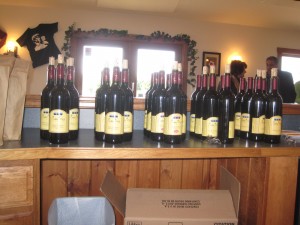
- Five Vintages of Cab Franc waiting to be poured, along with a mystery wine, hidden in brown bags for blind tasting
purchased) for early drinking, not for years in the cellar. Cab Franc will age, of course, but it is also more accessible when young than the more tannic reds. And Cab Franc can be used on its own or as a blend to make wines with great complexity, as the great St. Emilion blend, Cheval Blanc, demonstrates.
Cab Frank is particularly important to my wife, the Vineyard Goddess, and me, because it’s one of three grapes we will be planting this Spring, the other two being Petit Verdot and Viognier. (We had hoped to plant Petit Manseng as well, but couldn’t find the certified vines we wanted.)
So, I was thrilled to have the opportunity Saturday to participate in a vertical tasting of Cab Francs at Gadino Cellars in Washington, VA (Rappahannock County). We tasted wines from 2005, 2006, 2007, 2008, and 2009, plus a barrel sample of the 2011. The Gadinos threw in a mystery wine, which we tasted blind. More on the mystery wine later. Continue Reading–>

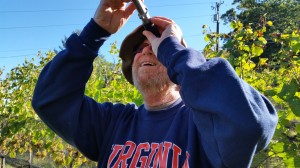
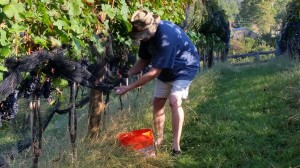
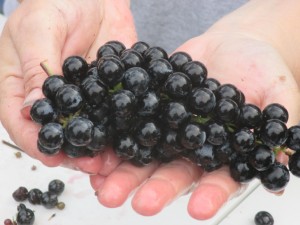
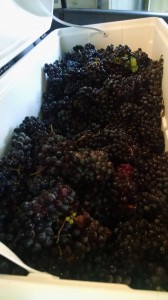
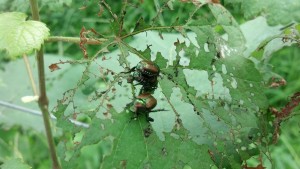
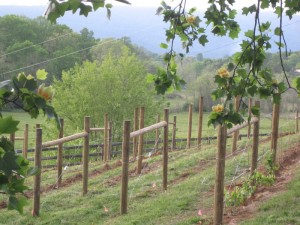
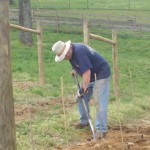
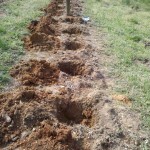
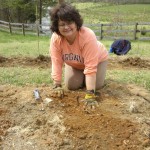
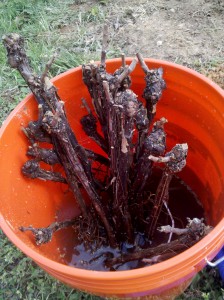
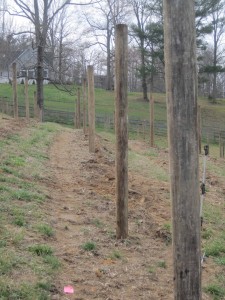
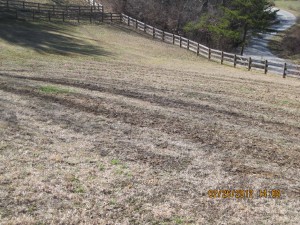
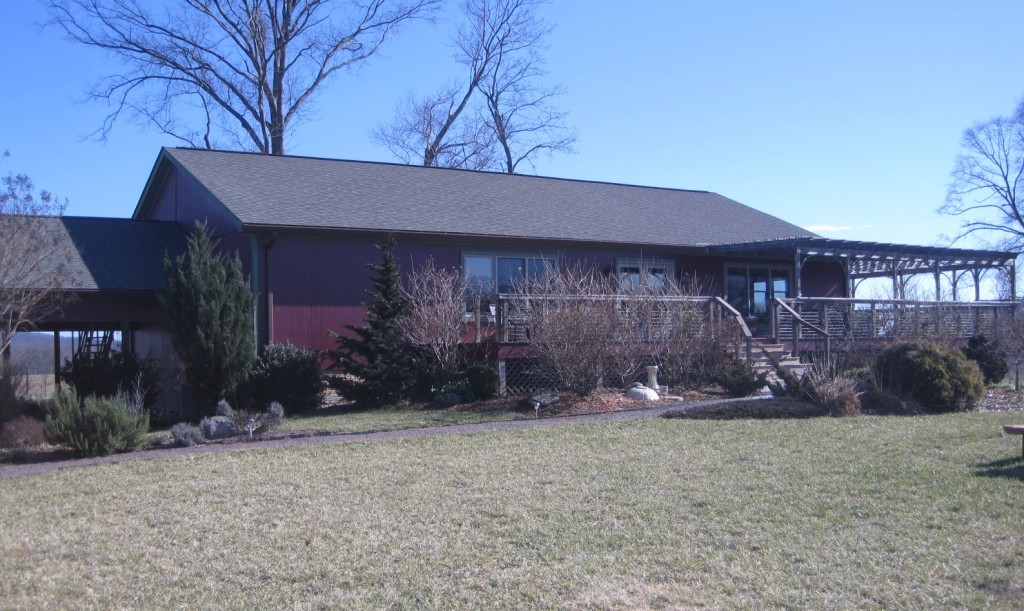


Recent Comments